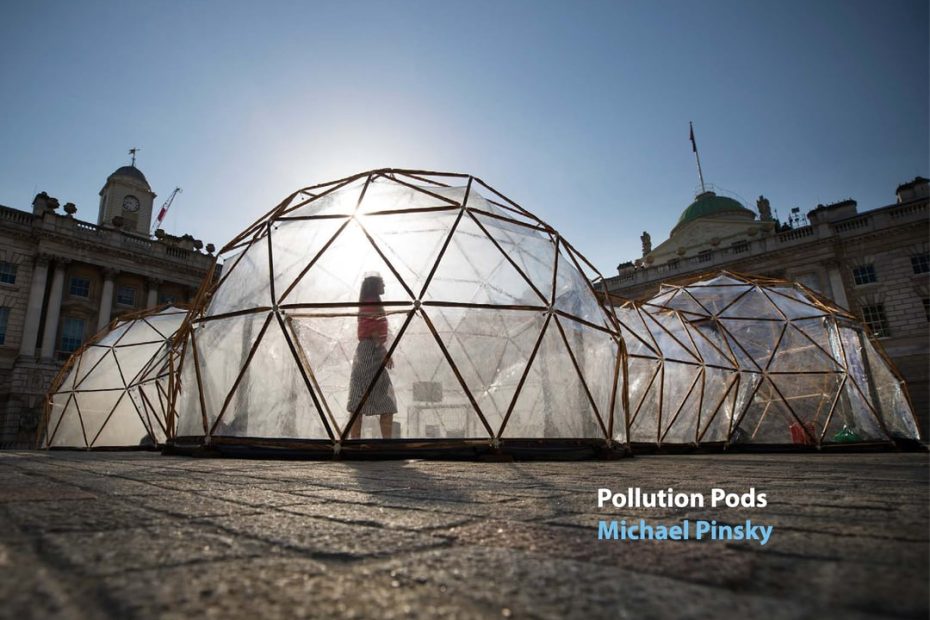Five geodesic domes are connected to form a ring. Within each dome the air quality of five global cities is recreated. A carefully mixed recipe emulates the relative presence of ozone, particulate matter, nitrogen dioxide, sulphur dioxide and carbon monoxide which pollute these cities. Starting from the hosting city, the visitor passes through increasingly polluted cells, from dry and cold locations to hot and humid.
The release of toxic gases from domestic and industrial sources both increase the rate of global warming and have a direct effect on our present day health. In the West, in cities such as London, one in five children suffer from asthma. Whilst in the developing countries such as Delhi, over half the children have stunted lung development and will never completely recover. However, this pollution is difficult to understand through images, as the smog of such as Delhi seems almost romantic and much of the most dangerous toxins are not visible at all.
Much of this pollution is driven by
the insatiable appetite of capitalist consumerism. Whilst we here in the developed world live in an environment with relatively clean air, people in countries such as China and India are being poisoned by the air borne toxins created from industries fulfilling orders from the West.
The experience of walking through
the pollution pods demonstrates that these worlds are interconnected and interdependent. Our need for ever cheaper goods is reflected in the ill- health of many people in world and in the ill-health of our planet as a whole. In this installation we can feel, taste and smell the environments that are the norm for a huge swathe of the world’s population.
Background
The Pollution Pods were developed as part of Climart an interdisciplinary and international research project, which has brought together environmental psychologists, natural scientists and artists in order to investigate how environmental art functions as a tool for climate change communication.
The Climart team collaborated with chemists at the Norwegian Institute of Air Research and AirLabs to produce convincing representations of polluted air in cities around the world. This research has expanded to included scent specialists from the UK and Holland.
The installation was first shown in Trondheim as part of the STARMUS festival which combined presentations from leading artists, astronauts and scientists including Steven Hawkins and Charlie Duke. Subsiquently, the installation was shown in Somerset House in London.
Pollution Pods has been central to the Climart research project where a team of psychologists from the Norwegian University for Science and Technology (NTNU) have been trying to establish whether art can change people’s perception of climate change.
The Climart team are as follows:
- Christian A. Klöckner, environmental psychologist, NTNU (project leader)
- David Buckland, Director, Cape Farewell
- Sam Jury, artist, (co-coordinator)
- Laura Sommer, environmental psychologist, NTNU
- Paul Stern, environmental psychologist, National Research Council
- Janet Swim, environmental psychologist, Penn State University
- Martina Zienert & Joachim Borner, environmental communicators, Kolleg fuer Management und Gestaltung nachhaltiger Entwicklung
- Peter Huybers, climate scientist, Harvard University
- Edgar Hertwich, environmental scientist, Yale University
Technical Aspects
The installation consists of a frame made from Norwegian reclaimed wood with bark on the external face. From this hangs a PVC bioplastic membrane. The pollution is emulated in a variety of different ways within the pods using humidifiers, haze generators, diffusers, fans and an ozone machine. The temperature and humidity is regulated by heaters and air condition- ers.
The overall installation requires a peak power supply of 63 amps, though the current it pulls on average is under 30 amps.
This installation is packed within eight- palletted crates each 1.2 x 1.0 x 1.8 me- tres and weighing 1500 kilos in total. It can be transported by ship or in a long wheel based transit van.
The construction of the installation requires ten technicians working over two days. The deconstruction requires ten technicians working over one day.
Whilst the installation is open to the public it requires a minimum of two in- vigilators to monitor both the public and regulate the pollution emulation. Two fire extinguishers are provided with the installation.
Technical Drawings can be downloaded here.
Safety Data Sheets can be downloaded here.




